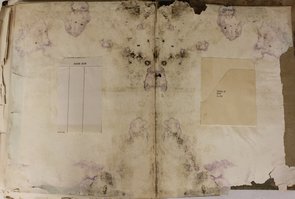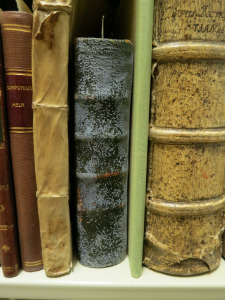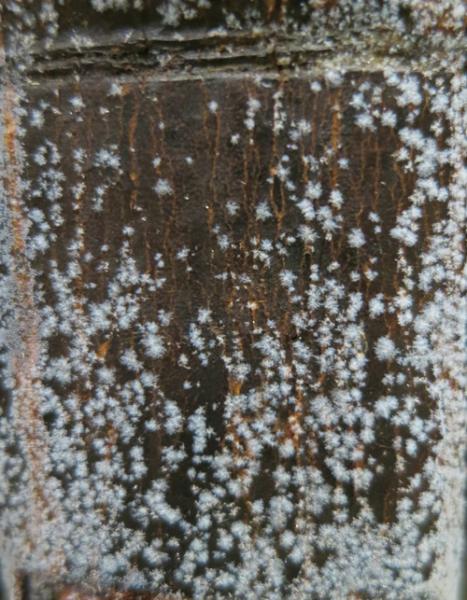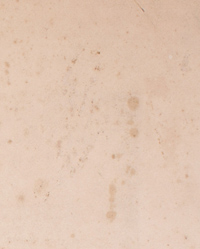Mold is a type of fungus that thrives when it finds a suitable food source and the right level of humidity. It can appear as thread-like patches, fuzzy spots, or even dense, spider-web-like growths. Mold is most commonly found on natural, porous materials like cotton, linen, silk, wool, leather, and paper. It spreads by releasing spores into the air, which allows it to “jump” from one book to another.
Signs of Mold on Books
Your book may be affected by mold if you notice any of the following:
– Fuzzy growth in almost any colour imaginable
– Stringy, white filaments stretching across porous surfaces
– Signs of past water damage
– Unusual spots or stains
What About Mildew?
Mildew often appears alongside mold, but it is a distinct type of fungus. However, any soiled or moldy surface can provide a suitable environment for mildew.
Once mildew finds the ideal combination of temperature and humidity, it can spread rapidly.
Signs of Mildew on Books
Your book may have mildew if you notice these issues:
A distinct “old book smell,” which often lingers even after mildew is removed.
A thin haze, clusters of spots, or a powdery, flaky layer, typically white, grey, or black, on the book’s surface.
Understanding the differences between mold and mildew, as well as their warning signs, can help you take swift action to protect your books and prevent further damage.
Examples of mold (or otherwise) #

Is it Mold?
No.
These red or rust-colored spots are called foxing. Although it is disfiguring, foxing does not weaken the paper and is not a cause for concern.

Is it Mold?
Yes – inactive.
Inactive mold is dry/powdery and will have a slightly raised appearance. Inactive mold can become active under the right conditions and may cause an allergic reaction in sensitive individuals. Handle with caution.

Is it Mold?
No.
This damage was caused by mold, but no mold is present. Active mold produces digestive enzymes that can weaken or leave losses in paper or cloth. Check the rest of the volume for other signs of mold.

Is it Mold?
Yes and No.
The brown stains at the top of the image are simply dirt and are not cause for alarm. The circular, purple stain in the centre of the page is damage caused by mold enzymes, but mold is no longer present in this area. The brownish/black powder at the bottom of the page is inactive mold and should be handled with caution.

Is it Mold?
Yes.
Active mold will appear hairy or fuzzy and will feel wet or smear when touched. Mold can spread quickly and is a hazard to library collections as well as human health.
Handle with caution. Check nearby items for signs of mold.
Wash your hands and wipe down surfaces after handling moldy items.
More visual examples of Mold on Books #
Mold Photographs:


White Mold:

Efflorescence:
Efflorescense on book spine

Efflorescense close up

The Difference Between Mold & Foxing #

Foxing is rust colored spots which occur on paper resulting from oxidation of both organic and iron impurities left behind during the paper making process.
Only when these impurities exist in the paper, given exposure to the right humidity and temperature factors, will foxing occur.
This process is intrinsic to the paper; some paper will never have the rusty, brown, yellow spots known as foxing.
Preventing Mold and Mildew on Books #
Excessive humidity is the primary factor that promotes mold and mildew growth. Still, moist air provides the perfect environment for mold spores to thrive and spread. Think of damp basements, stale attics, or clothes left in a washer for too long—these conditions are ideal for mildew development.
Here’s how to safeguard your books:
Choose the Right Location: Store your books on a shelf with good air circulation, avoiding closets, basements, or shelves positioned against exterior walls of your home.
Maintain Airflow: Use fans to improve air circulation. During summer, utilise an air conditioner, and in winter, use a heater to maintain a consistent temperature of around 21°C (70°F).
Control Humidity: A dehumidifier can help keep the relative humidity below 60%. However, use it cautiously, as excessively dry conditions can cause books to crack or become brittle.
Be Cautious with Houseplants: While houseplants can enhance a room’s ambience, they introduce moisture. Keep them away from your bookshelves to minimise risk.
Dust Regularly: Clean the tops of your books frequently. Dust-free surfaces are less likely to attract mold spores.
Consider Natural Remedies: Some collectors lightly apply lavender essential oil to bookshelves due to its antifungal properties. Be aware that this may scent your books or cause discolouration.
Avoid Prolonged Light Exposure: Keeping a small electric light in your bookcase can deter mold but may cause fading or discoloration of book covers over time.
Implementing these measures will help create a safe and mold-free environment for your books, extending their lifespan while preserving their condition.
